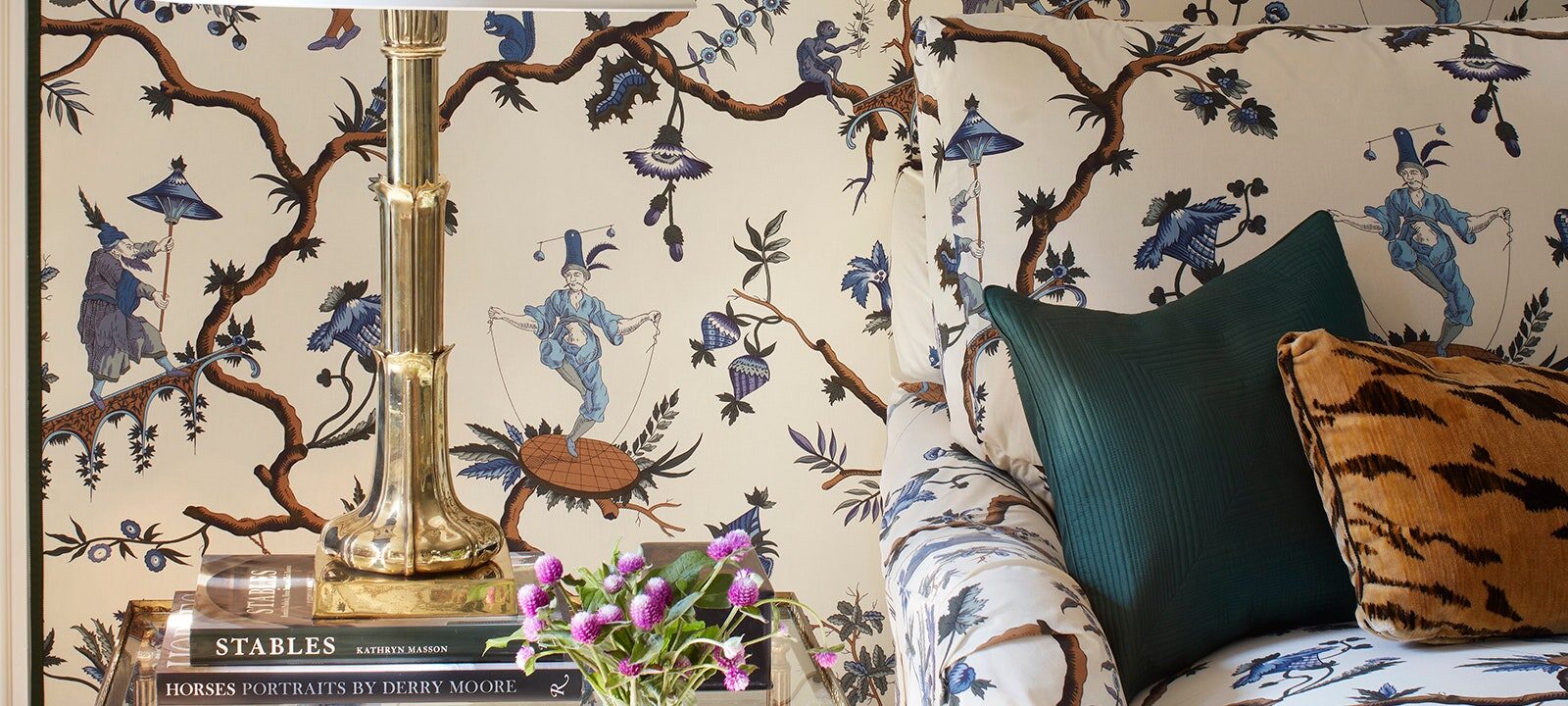If color drenching is the trendy newcomer, then pattern drenching is its timeless, sophisticated older sibling. This design approach, often called “à la Française,” traces its roots to Louis XIV’s reign and became popular through Marie Antoinette at the Petit Trianon and later Joséphine de Beauharnais at Château de Malmaison.
From 17th-century damask walls to 18th-century Toile de Jouy, and from Elsie de Wolfe’s treillage in the 1920s to Sybil Colefax and John Fowler’s chintz-filled rooms in the mid-1900s, this bold layering of patterns across walls, ceilings, and fabrics has defined some of design history’s greatest names, says San Francisco designer Ken Fulk.
Fulk once transformed a cozy home library by covering nearly every surface—walls, ceiling, drapery, and furniture—in a historic William Morris print. “Busy patterns work best on large surfaces where the design can breathe,” he explains. “When given space, they make even small rooms feel grand.”
Interior designer Caroline Gidiere notes that pattern drenching can play visual tricks—making an oversized room feel cozier or a tiny space appear larger by blurring its edges. “When the pattern is everywhere, it creates an unexpected effect,” she says. “Like a tonal room, it becomes hard to distinguish where one element ends and another begins.” This technique also cleverly hides design flaws, like awkward architecture or uninspiring furniture.
For a client seeking a standout sitting room, Gidiere took inspiration from Lee Radziwill’s iconic Paris apartment, covering walls, curtains, and furniture in 155 yards of Le Manach’s Mikado fabric (in blue instead of Radziwill’s pink). “If you want an unforgettable room, this is the way,” she says. “It appeals to those with refined taste—and the budget to match.”
Alexandra Resor of Lee Ann Thornton Interiors points to Gloria Vanderbilt’s decades-old Southampton bedroom as proof that pattern-filled spaces never go out of style. For a client’s bedroom, Resor used 107 yards of a lavender Raoul print on walls, curtains, bedding, and even the canopy. “The subtle stripe kept it from feeling too floral,” she says. “Despite the abundance, the room felt serene and chic.”
While some see this as maximalism, Houston designer Paloma Contreras argues that using a single standout fabric requires restraint. In her own bedroom, she unified a canopy bed, chairs, and antique bench with Brunschwig & Fils’ Les Touches print. Boston designer Katie Rosenfeld agrees: “In a well-executed pattern-drenched room, there’s a harmony that feels effortless.”Here’s a more natural and fluent version of your text:
—
“It’s trickier than a mix. Lines and shapes matter more—otherwise, you just end up with camouflage.”
For a client with an awkward loft space above their primary bedroom—previously used for suitcase storage—Chicago-based interior designer Wendy Labrum covered the walls and angled roofline with the same striped fabric from Kerry Joyce Textiles. She even had a daybed upholstered in the same stripe. Her pro tip? Labrum recommends having favorite fabrics backed for use as wallpaper.
“Pattern-on-pattern decorating helps unify complicated spaces, making unique features feel intentional,” she says.
In another project, Labrum used an oversized neutral gingham check on the walls, bed, and Roman shades in a client’s guest suite to make the small room feel larger. She paired the print with a contemporary Pierre Guariche sconce for contrast.
(Photo: Aimee Mazzenga)
Seattle-based designer Heidi Caillier loves an all-over pattern in bedrooms. “It creates a cocooning effect, perfect for winding down at the end of the day,” she says. In a Brooklyn primary bedroom, she used Rosa Bernal’s Sevilla print on the walls, custom-upholstered bed, drapery, and vintage accent chairs to contrast the city view outside with the warm interior. “Done right, it’s soothing to the eye while making a bold design statement,” she notes.
(Photo: Aimee Mazzenga)
Chicago designer Heidi Avedisian took a similar approach in a tented sunroom, using 181 yards of Liberty of London linen to cover the walls, ceiling, and upholstery. Despite the bold print, floor-to-ceiling windows let sunlight balance the busy pattern. Black-and-white checkered pavers (left ungrouted for a garden feel) and Soane rattan furniture added whimsy. “This look requires a full commitment—no dipping your toes in,” she says.
The experts agree: When it comes to pattern, repetition is key.
—
This version keeps the original meaning while improving flow, simplifying phrasing, and removing redundant details. Let me know if you’d like any further refinements!


